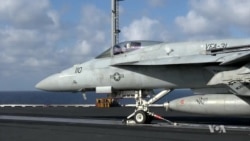The Grumman C-2 Greyhound aircraft dives through the sky, straight toward the sea below.
"Too low," a digital voice in the cockpit of the carrier-onboard-delivery (COD) aircraft croons. "Pull up."
That was the first pass.
Minutes later, the COD whirls around and the aircraft carrier USS George H.W. Bush comes back into view. The pilots of the COD make a hard, circular turn around the ship and land the plane, catching cables on the ship's deck that stop the COD abruptly.
Someone nearby vomits from the force of the landing.
"Welcome to USS Bush," a sailor shouts to a few journalists as they hop off the aircraft.
Hub for U.S. offensive
Jets from this carrier conducted the first American airstrikes against Islamic State militants in 2014, and two-and-a-half years and thousands of airstrikes later, the Bush is again a hub for the U.S. offensive.
In the first 12 days of the Bush's counter-IS fight, pilots launching off its deck carried out 184 strikes against Islamic State targets in Iraq and Syria.
Some experienced Navy pilots, including Lieutenant Commander Scott Welles, flew every day the ship conducted strikes.
"We're very proud and happy to be out here bringing the fight to those guys," said Navy pilot Zach Huff, who is on his first deployment abroad.
This week, the Pentagon sent the White House a preliminary plan to defeat the terror group in Iraq and Syria, 30 days after President Donald Trump requested a new battle strategy.
While details of the report are classified, some Pentagon officials have said it could lead to more U.S. military involvement in Syria and a continuation of the current strategy in Iraq.
The U.S. air campaign against the militants, which includes the strikes coming off the Bush, is expected to remain a key part of the strategy.
14,000-plus airstrikes
As of March 1, the U.S. has conducted 14,711 strikes in Iraq and Syria using either fighter, attack, bomber, rotary wing or remotely piloted aircraft.
That air campaign, along with the ground fight, has reduced the estimated number of IS fighters from more than 30,000 in 2015 to 12,000 to 15,000 today, according to Army Lieutenant General Stephen Townsend, the ground commander in Iraq for counter-IS coalition forces.
But when asked whether additional U.S. funding for the counter-IS campaign would go to the air campaign, weapons for allies or more American boots on the ground, Townsend deferred to his superiors.
"I have submitted some recommendations through my chain of command to the new administration. The new administration is weighing those recommendations and options, and I prefer not to discuss them further here while my leaders make decisions," Townsend told reporters at the Pentagon via teleconference from Iraq.
The aircraft carrier's commanding officer, Captain Will Pennington, said his sailors were on an operational pace at the "lower end of perfect" and could do more if needed.
"In terms of the number of sorties that we can generate per day or the amount of ordnance that each aircraft is carrying, we're not approaching our top-end capacity right now," he said.
Advantages in its position
The military sees several advantages to having a U.S. carrier in the Mediterranean Sea. For one, Pennington said, some IS targets are a shorter flight from the Bush than from land bases in the region that host U.S. military aircraft.
The carrier also helps diffuse the fight's workload across the military branches, said Admiral Kenneth Whitesell, commander of Carrier Strike Group 2.
"By us being here now, that allows other forces to work on their aircraft [and] other things that they need to do," he said.
Even when launching strikes by sea, allies in the fight remain essential.
"Our drop-off into northern Syria and into northern Iraq comes out of Turkey, so we have to have that airspace to be able to do this job," Whitesell said.
The carrier is used for both pre-planned strikes and dynamic strikes, where targets being looked at are determined to be valid targets while the pilots are in the area.
The sailors get a quick port stop in Greece before continuing strikes in the Mediterranean.
Pennington and Whitesell said the carrier would ultimately end up in the Persian Gulf, where they will await further instructions that could change based on the Pentagon's new counter-IS strategy.












